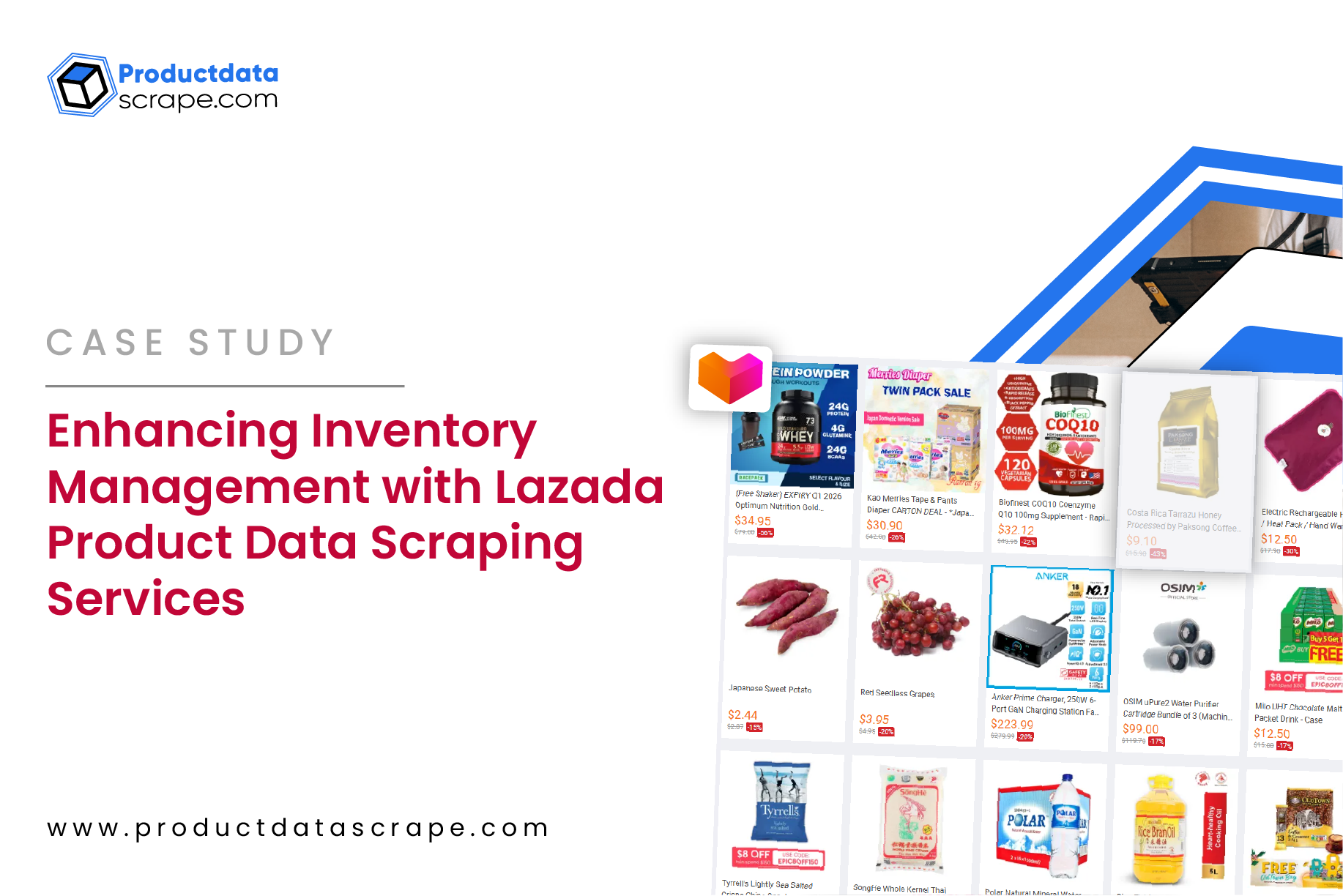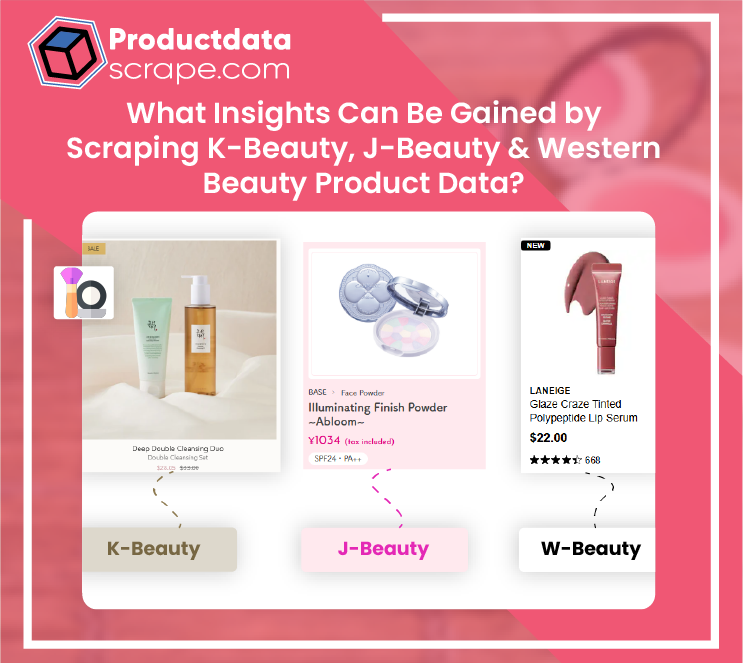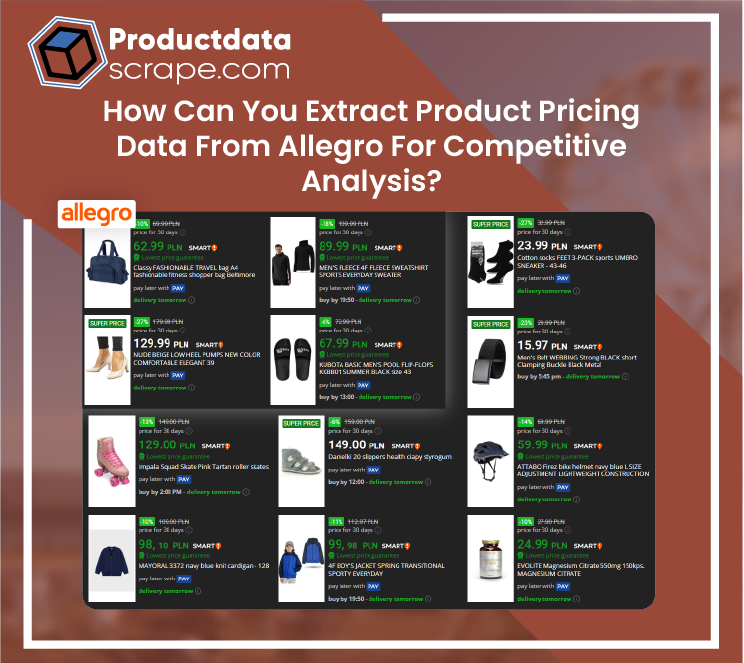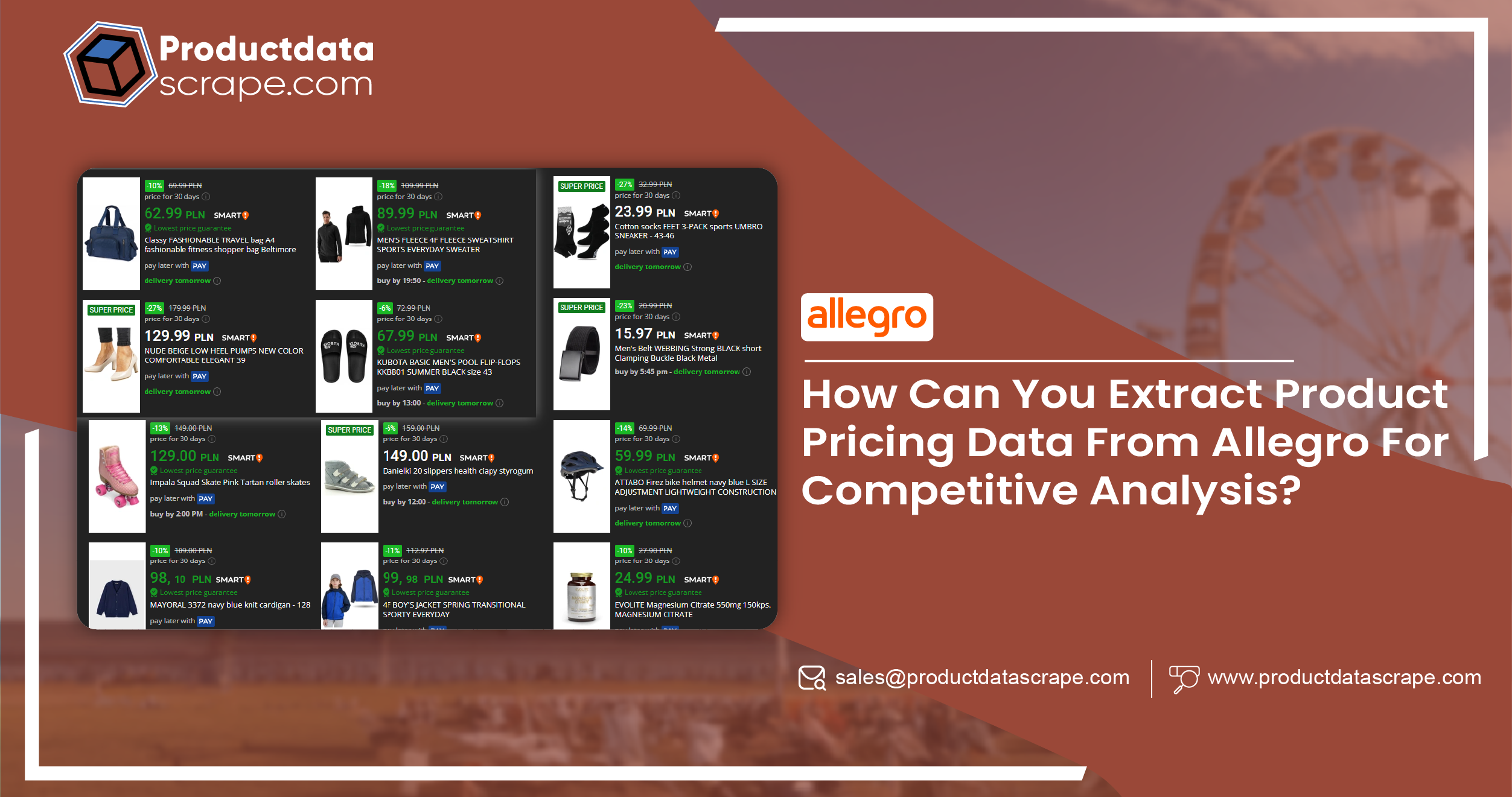
Introduction
Allegro, Poland's largest e-commerce platform, is a dynamic marketplace with millions of
electronics and fashion products, attracting over 20 million monthly users. Allegro's vast
dataset presents significant opportunities for businesses, researchers, and entrepreneurs,
including product names, prices, ratings, and more. By learning how to Extract Product Pricing
Data From Allegro, you can gain valuable insights into market trends and pricing strategies.
Additionally, the ability to Scrape Allegro Product Reviews and Ratings Data offers an edge in
understanding customer preferences and satisfaction levels. Similarly, the ability to Scrape
Allegro Product Listings Data helps monitor competitor offerings and optimize your product
lineup. However, extracting this data can be challenging due to Allegro's complex structure and
anti-bot measures. This blog will provide a clear, actionable guide to scraping Allegro's data
using Python and modern scraping tools, ensuring a straightforward and efficient process to
access valuable e-commerce insights.
Why Scrape Allegro?
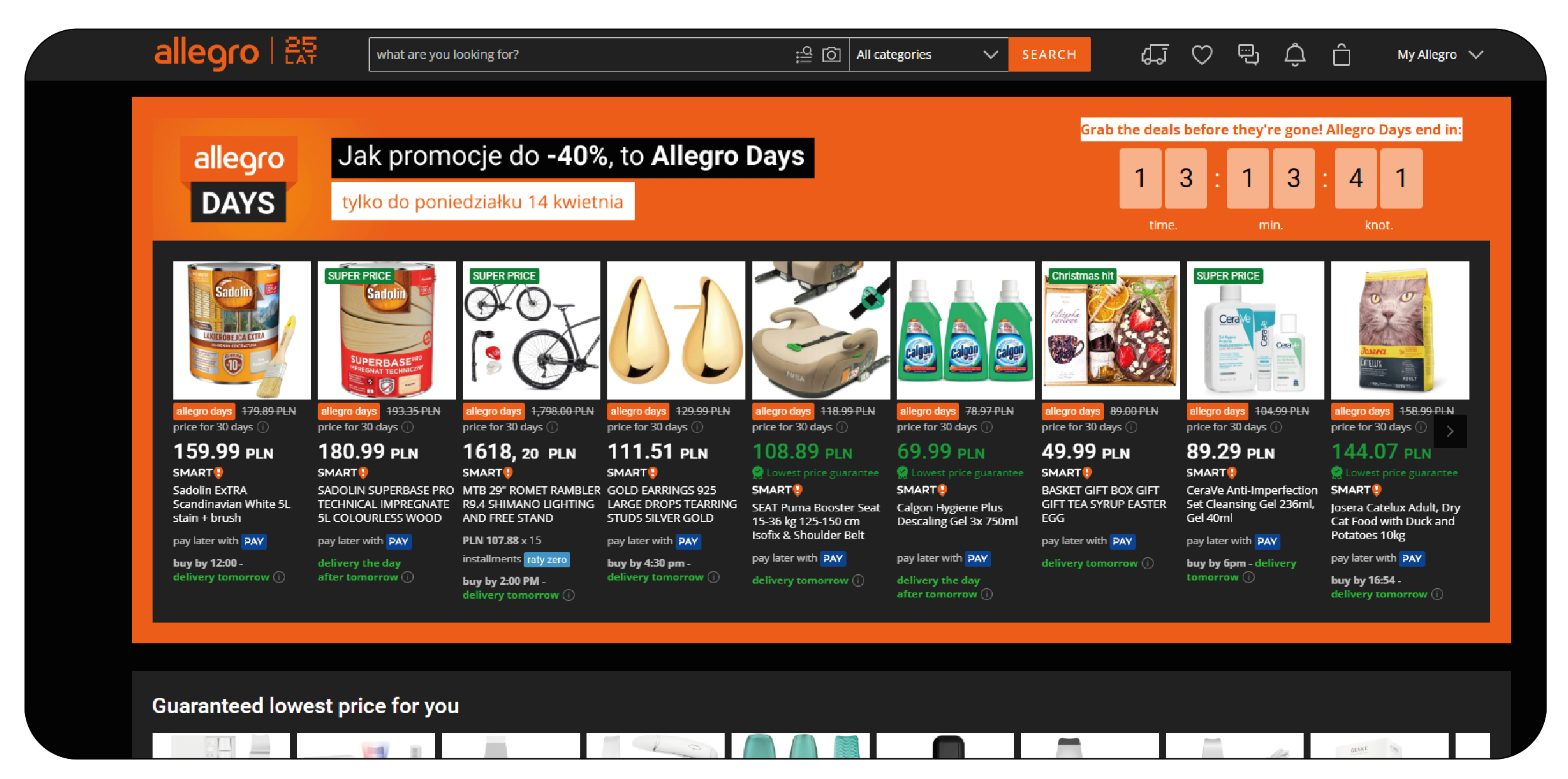
Allegro is more than just an online store; it is the heartbeat of the Polish e-commerce market
and has extended its influence across neighboring countries with localized platforms like
allegro.cz and allegro.sk. Scraping Allegro's extensive data offers valuable insights that can
help businesses, entrepreneurs, and researchers make informed decisions. Here's how Web Scraping
Product Pricing Data From Allegro can benefit you:
-
Market Analysis: Scraping Allegro lets you track product pricing trends and
identify high-demand categories.
For example, electronics tend to surge in demand right before Christmas, and Extract Pricing
Data From Allegro can help you spot
such seasonal trends in advance. By analyzing the pricing data, you can adjust your strategy
to take advantage of these surges,
ensuring better sales performance.
-
Competitor Monitoring: Allegro Product Data Scraping lets you gather
valuable data about your competitors.
You can refine your business approach by analyzing their product listings, pricing
strategies, and discounts. Scraping these
insights helps you stay ahead of your competition, ensuring that your pricing and product
offerings are on point.
-
Consumer Insights: Understanding consumer sentiment is key to any business.
By scraping Allegro's product
reviews and ratings, you gain insights into what customers love or dislike about products.
This allows you to tailor your
offerings, improve product features, and run more effective marketing campaigns. Analyzing
customer feedback will help you
meet market demands more precisely.
-
Dropshipping and Reselling: With Allegro ECommerce Data Extraction, you can
automate the import of product
details such as images, SKUs, and availability into your store. This makes the drop shipping
and reselling process much
smoother and more efficient. By scraping Allegro product data, you can keep your inventory
up-to-date without manually
checking each item.
-
Research: Allegro's vast dataset is a goldmine for academic research,
particularly in e-commerce trends,consumer behavior, and regional market dynamics. Whether you're studying the Polish market
or exploring broader trends across Central and Eastern Europe, Extract Allegro.pl E-Commerce Product Data can provide the
necessary data for robust research
and analysis.
The challenge, however, lies in Allegro's complex structure. The platform features dynamic pages
with JavaScript-heavy content, which makes traditional scraping techniques difficult and
tedious. Additionally, Allegro employs anti-scraping measures to prevent unauthorized data
extraction, adding an extra layer of complexity. Fortunately, with the right approach and modern
scraping tools, Web Scraping Allegro.pl E-Commerce Product Data is easy. This ensures that even
beginners can navigate the platform's complexities and extract valuable data, empowering them to
harness Allegro's full potential for market analysis, competitive research, and business growth.
Understanding Allegro's Data Landscape
.webp)
Before diving in, map out what you can scrape from Allegro. Its product pages are packed with
details, including:
-
Product Title: The name, often with brand and model
(e.g., "Apple iPhone 14 Pro 128GB Silver").
-
Price: Current price, discounts, or promotional offers
listed in PLN (Polish złoty).
-
Ratings and Reviews: Star ratings and buyer feedback
showing product popularity and quality.
-
Seller Information: Seller name, rating, and whether
they offer "Allegro Protect" for buyer security.
-
Specifications: Details like size, color, material, or
technical features (e.g., "6.1-inch OLED display").
-
Images: High-quality product photos for visual analysis
or catalog use.
-
Availability: Stock status, shipping options, and
estimated delivery times.
-
Category and Tags: Where the product sits
(e.g., "Electronics > Smartphones") and keywords like "bestseller."
These elements are scattered across Allegro's HTML, often loaded dynamically via JavaScript,
requiring tools to handle modern web complexities. Now, let's set up your scraping toolkit.
Choosing the Right Tools
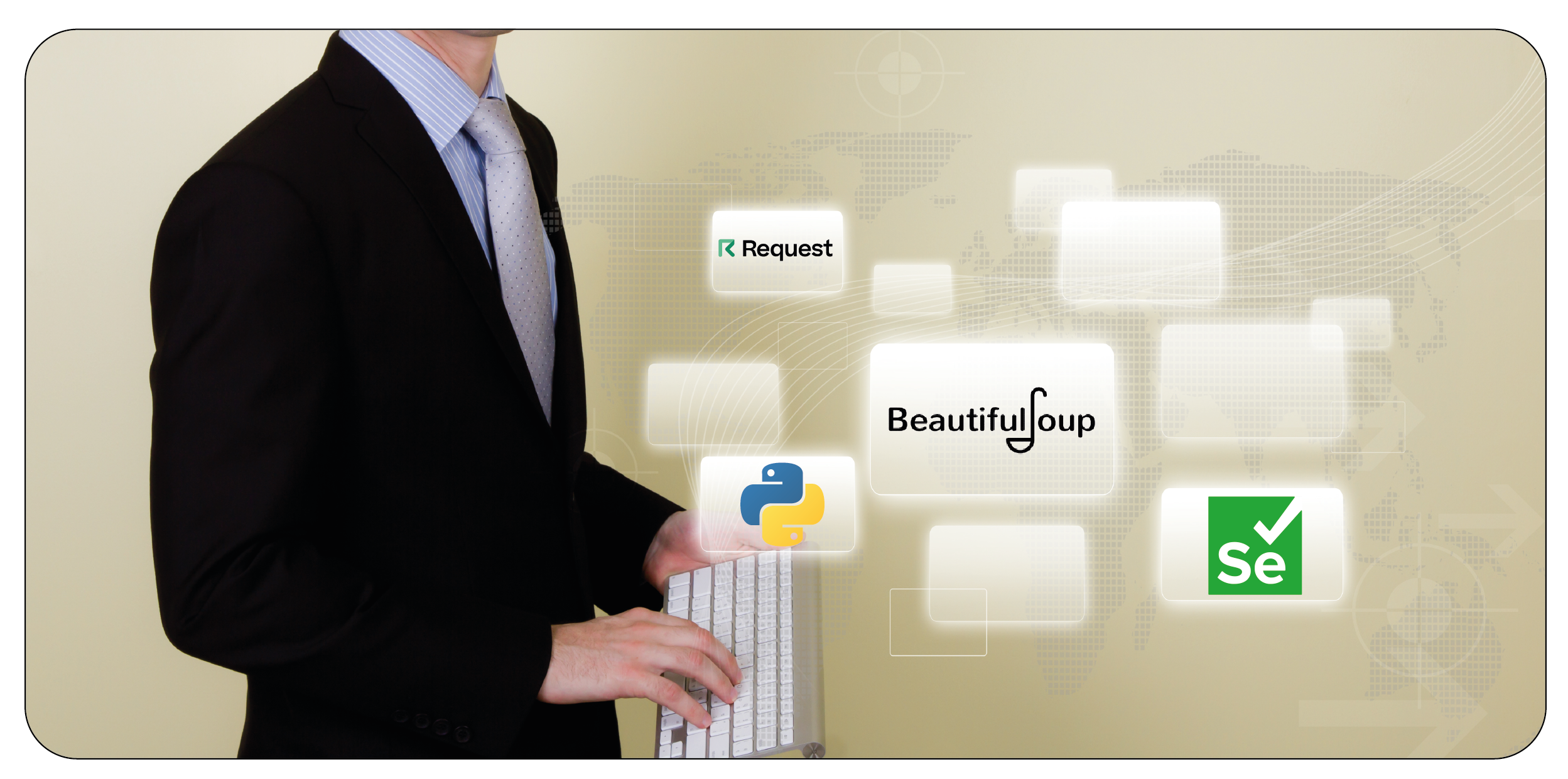
To scrape Allegro easily, you need tools that balance power and simplicity. Python is the ideal
language, thanks to its flexibility and rich ecosystem. Here's what you'll need:
-
Python 3.7+: The backbone for scripting your scraper.
-
requests: For sending HTTP requests to fetch page content (ideal for APIs
or static data).
-
BeautifulSoup: To parse HTML and extract specific tags like product titles
or prices.
-
Selenium: For handling dynamic content and automating browser interactions
to load JavaScript-rendered data.
-
Pandas: To organize scraped data into structured formats like CSV for
analysis.
-
WebDriver: A browser driver (e.g., ChromeDriver) for Selenium to control a
real browser.
-
Optional Proxy Service: To avoid IP blocks, especially for large-scale
scraping, use advanced services.
Install these with pip:
pip install requests beautifulsoup4 selenium pandas
Download ChromeDriver matching your Chrome version, and you're ready to go. If you're new to Python, Jupyter Notebook is an excellent environment to test code interactively.
Planning Your Scraping Strategy

Web Scraping Allegro.pl E-Commerce Product Data starts with a plan. Decide what data you need
and where to find it. For example:
-
Single Product Page: Grab details like title, price, and specs from a
specific URL
(e.g., an iPhone listing).
-
Category Listings: Scrape multiple products from a search page
(e.g., "laptops") to compare prices or brands.
-
Search Results: Target keyword-driven results
(e.g., "wireless headphones") for trend analysis.
For this guide, we'll focus on E-commerce Data Extraction for a category listing page to collect
product titles, prices, and ratings, then save them to a CSV. Category pages display dozens of
products, making them ideal for bulk data collection. A sample URL might be
https://allegro.pl/kategoria/laptopy, listing laptops across brands.
Writing the Scraper
To scrape Allegro's laptop category, build a Python script using Selenium and BeautifulSoup.
Selenium will load the page entirely, while BeautifulSoup parses the HTML for clean extraction.
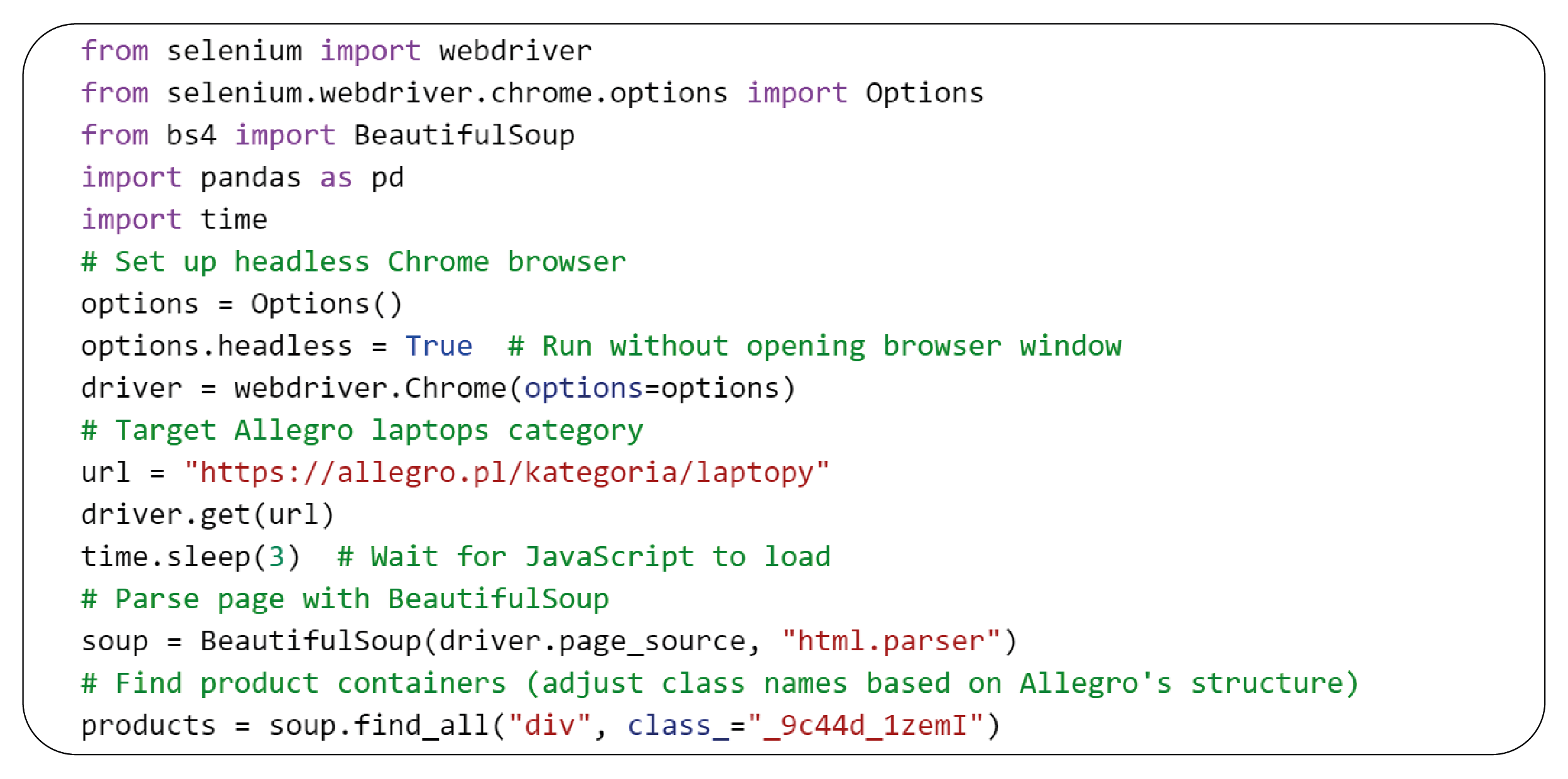

How It Works?
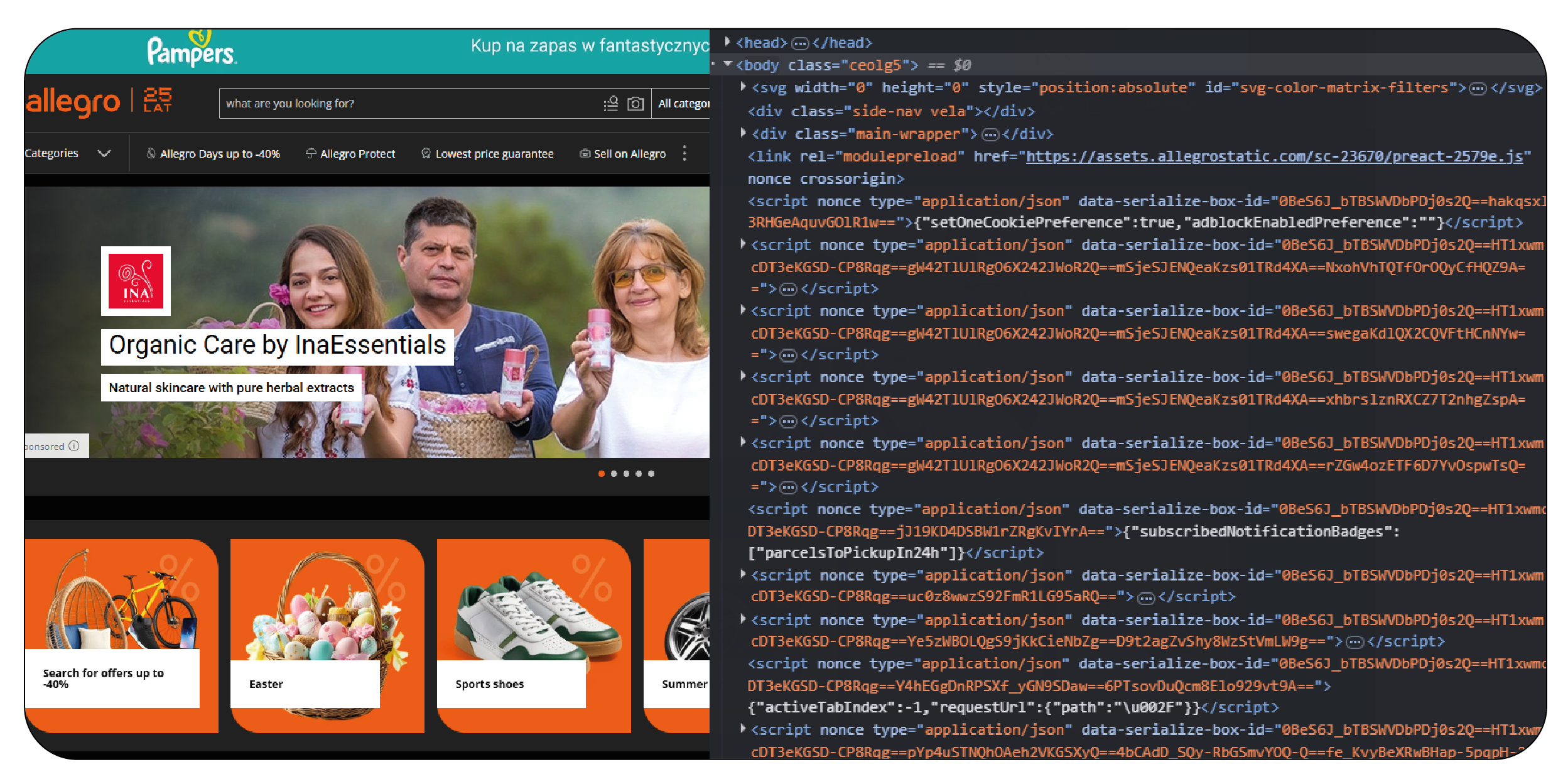
-
Selenium Setup: Configures a headless Chrome browser to load the
category page, waiting briefly for JavaScript to render dynamic content.
-
Page Parsing: BeautifulSoup takes the fully loaded HTML and searches for
product containers using Allegro's class names
(you'll need to inspect the page with Chrome DevTools to find current classes, as they
change).
-
Data Extraction: Loops through products, pulling title, price, and
rating from specific tags. If a tag is missing, it defaults to "N/A" to avoid errors.
-
Data Storage: Saves results in a pandas DataFrame, exported as a CSV for
easy analysis.
Note: Allegro's class names (e.g., _9c44d_1zemI) are dynamic and may change.
Use Chrome's "Inspect" tool to find the latest classes by right-clicking a product title or
price on the page. Update the script accordingly.
Scaling Up Your Scraper
The basic script works for a single page, but Allegro's category listings often span multiple
pages. To scrape more products:
-
Handle Pagination: Find the "Next" button's link
(e.g., <a class="next">) and use Selenium to click it or construct the next page's URL
(e.g., ?page=2).
-
Loop Through Pages: Modify the script to iterate until no "Next" button
exists.
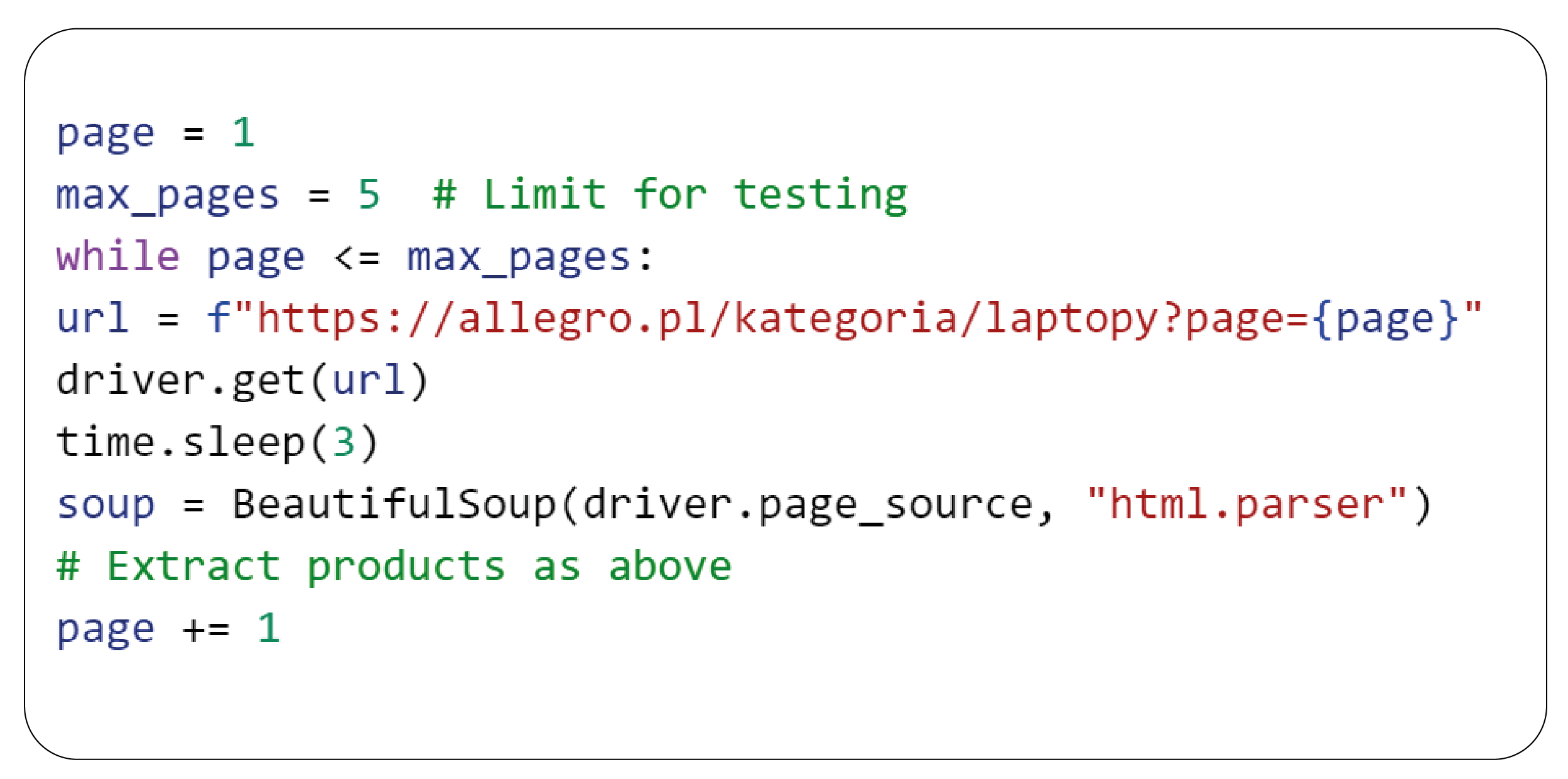
-
Target Specific Products: Instead of a category, use a search URL
(e.g., https://allegro.pl/listing?string=wireless%20headphones)
to focus on niche items.
-
Add More Fields: Extend the script to scrape images (<img src>),
seller names, or shipping details
by identifying their HTML tags.
Consider a proxy service to rotate IPs and prevent blocks from large-scale scraping. Free
proxies
are unreliable, so paid options like Scrape offer Polish residential IPs for seamless access.
Analyzing Your Data
Once scraped, your CSV file (e.g., allegro_laptops.csv) is ready for analysis. Use pandas to
explore trends:
-
Sort by Price:
df.sort_values("Price") to find the cheapest
laptops.
-
Filter High-Rated Products:
df[df["Rating"] > "4.5"] to focus
on top performers.
-
Visualize Trends: Plot price distributions with Matplotlib.

These insights can guide pricing strategies, identify gaps in the market, or highlight consumer
preferences.
Enhancing Your Scraper
To make your scraper more robust:
For advanced users, frameworks like Scrapy can replace Selenium for faster crawling, though they
require more setup. Scrapy's middleware can handle proxies and retries, which are ideal for
scraping thousands of products.
Turning Data into Action

Scraped Allegro data fuels real-world applications across various industries. A marketer could
analyze ratings to craft ads highlighting high-quality items, enhancing customer engagement.
Researchers might study price fluctuations to predict economic trends in Poland, providing
valuable insights. The CSV format ensures flexibility—import it into Excel, Google Sheets, or
databases like SQLite for deeper analysis.
For example, a small electronics retailer could scrape Allegro's smartphone category weekly,
tracking price drops to time their promotions. By comparing seller ratings, they could identify
trusted suppliers for partnerships. The data's versatility makes it a springboard for creativity
and strategy. Allegro Data Scraping Services allows businesses to tap into this wealth of
information quickly and efficiently. Ecommerce Data Scraping Services also offer scalable
solutions for extracting data from multiple platforms, enhancing decision-making across various
sectors.
How Product Data Scrape Can Help You?
-
Comprehensive Product Information: Our e-commerce data scraping services
collect detailed product data,
including names, descriptions, prices, images, and SKUs, providing a complete catalog for
analysis.
-
Competitive Price Monitoring: We help you track competitor pricing in
real-time, allowing you to stay ahead of
market trends, identify price fluctuations, and adjust your strategy accordingly.
-
Customer Insights: Our scraping solutions capture ratings and reviews,
giving you valuable feedback on customer
satisfaction, product performance, and potential areas for improvement.
-
Stock and Availability Tracking: We provide real-time data on product
availability and stock levels, ensuring you
stay informed about product restocks or shortages and manage inventory effectively.
-
Market Trend Analysis: Our data scraping services enable you to monitor
changes in demand, spot seasonal trends,
and gather insights that drive more intelligent business decisions.
Conclusion
Scraping Allegro doesn't have to be daunting. With Python, Selenium, and BeautifulSoup, you can
extract product data easily, turning raw HTML into structured insights. Whether you're analyzing
laptop prices, monitoring competitors, or building a dropshipping empire, Allegro's data is
yours to explore. Start small with a single category, refine your script, and scale up as
needed. The Polish market is vibrant, and Allegro's millions of listings are a goldmine waiting
for you to dig in. Grab your tools, fire up Python, and start scraping—what trends will you
uncover today?
By utilizing Web Scraping E-commerce Websites, you can tap into the wealth of data from Allegro
and other platforms. Whether it's extracting prices, ratings, or reviews, creating an Ecommerce
Product & Review Dataset is invaluable for market analysis and competitive research. Start your
journey into scraping and unlock endless possibilities!
At Product Data Scrape, we strongly emphasize ethical practices across
all our services,
including Competitor Price Monitoring and Mobile
App Data Scraping. Our commitment to
transparency and integrity is at the heart of everything we do. With a global presence and a
focus on personalized solutions, we aim to exceed client expectations and drive success in data
analytics. Our dedication to ethical principles ensures that our operations are both responsible
and effective.



.webp)













